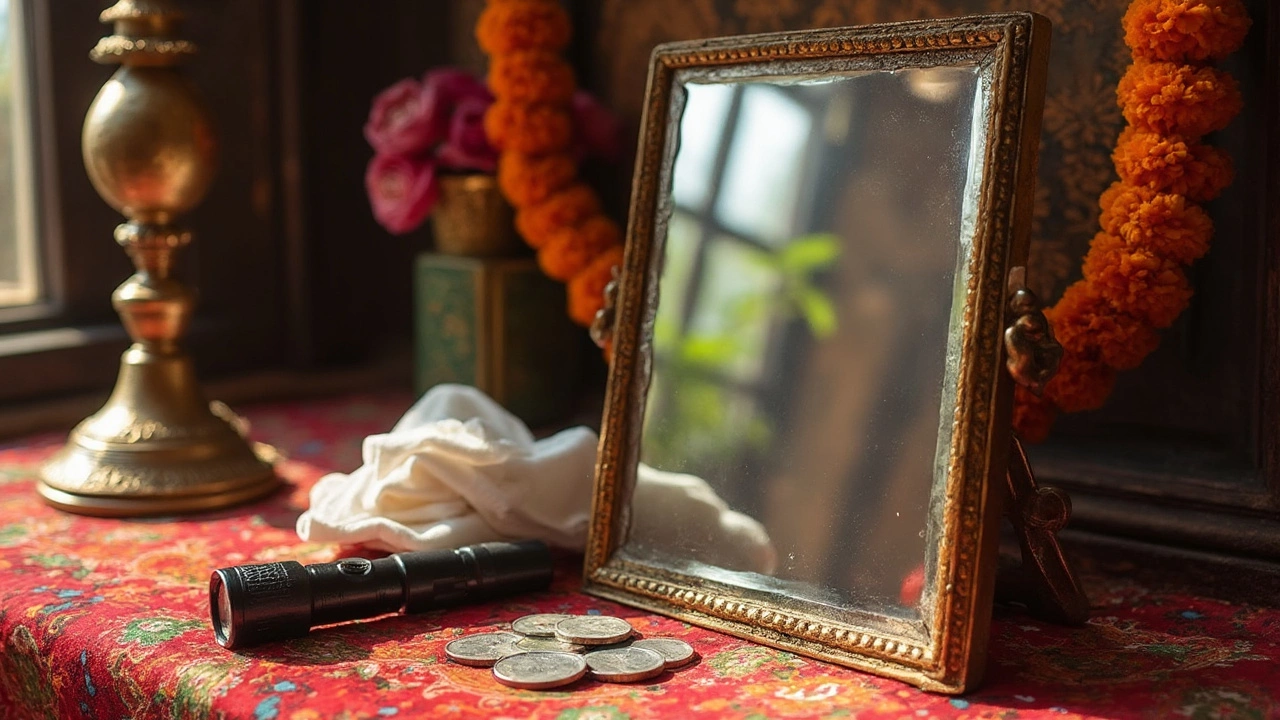Ever stared at your reflection and thought, “Why do I look a little weird?” Sometimes, it’s not you—it’s the mirror. Most people don’t realize there’s a big gap between cheap mirrors and ones that actually show you true, clear reflections. The difference is all in the details: the quality of glass, the coating at the back, and even how the edges are finished.
If you’ve hunted for mirrors lately, you’ve probably noticed how prices can jump all over the place. But a higher price tag doesn’t always mean top quality. Knowing what makes a mirror actually good (not just shiny) can save you money and frustration. Whether it's for your bathroom vanity, a hallway accent, or a massive wall piece, understanding those quality checkpoints means no more warped faces or weird spots glaring back at you.
It’s super easy to tell a cheap, poorly-made mirror apart from a great one—if you know what to look for. You don’t need special training. Just a couple of tricks and quick checks can make all the difference when you’re shopping or just questioning the mirror you already have at home. Ready for some practical tips? Let’s break it down step by step.
- What Makes a Mirror 'Good Quality'?
- How to Inspect Mirror Glass
- The Secret Behind the Backing
- Edges, Frames, and Little Details
- Quick Tips to Test at Home
What Makes a Mirror 'Good Quality'?
Not all mirrors are made the same, and it absolutely matters if you want something that lasts and actually gives you a true reflection. So, what really separates good mirrors from disappointing ones?
The first thing: high-quality mirrors start with clear, flat glass. Any warping in the glass—even small waves or unevenness—will throw off your looks, sometimes making your face look stretched or pinched. That’s why most decent mirrors use float glass, which gives you a super flat surface.
Behind that glass is a reflective coating, usually silver or sometimes aluminum. Silver is the gold standard (go figure!) because it gives the best reflectivity and truest color. A mirror quality jumps way up when real silver is behind the glass. But silver is expensive, which is why budget mirrors often skimp and go with cheaper coatings like aluminum or even a bad paint job.
Then comes the backing. A real, well-made mirror will have a thick, even coat of specialized backing paint to protect the silver from air and moisture. If moisture sneaks in, you end up with those ugly black spots and peeling we’ve all seen on old, low-quality mirrors.
Let’s not forget safety. Good mirrors are often made with tempered or laminated glass, especially ones designed for bathrooms or areas where breaks could be dangerous. That means if the glass does crack, it won’t shatter into a million tiny shards.
To sum it up, here’s what you want in a high-quality mirror:
- Flat, clear float glass for distortion-free reflection
- Real silver backing for the sharpest, truest reflection
- Thick, even protective paint on the back to block moisture
- Tempered or laminated glass for added safety (especially in public or wet spaces)
- Clean, finished edges—rough or unfinished edges are red flags
Bottom line: a truly good mirror isn’t just about looking shiny at first glance. It’s all about the details that keep it clear, accurate, and sturdy for years to come.
How to Inspect Mirror Glass
The first thing to check is the glass itself. You want a mirror that gives a sharp, undistorted image—not one that makes your face look stretched or wavy at the edges. Here’s how you can tell:
- Mirror quality starts with how flat the glass is. Stand at different angles and look if your reflection bends or gets distorted. Any warping means the glass wasn’t cut or finished well.
- Look at the thickness. Standard home mirrors usually range from 1/8 inch (3mm) to 1/4 inch (6mm), but 1/4 inch is sturdier and less likely to flex or break over time. Thicker glass generally means better durability.
- Check for color clarity. High-quality mirrors use clear glass, but cheaper ones can look slightly green or gray around the edges, which comes from using low-grade glass with more iron content.
- Surface flaws matter too. Run your hand gently across—bumps, scratches, or bubbles are signs of poor manufacturing.
Need a quick at-home test? Hold up a pen or your finger, touching the mirror. In a good mirror, there will be barely any gap between your finger and its reflection—almost touching. If there’s a big gap, the glass may be too thick, or the reflective coating is placed incorrectly, causing a double-image effect.
| Mirror Characteristic | Cheap Mirror | Good Quality Mirror |
|---|---|---|
| Glass Thickness | 3mm (1/8"); flexible, fragile | 6mm (1/4"); sturdy, solid feel |
| Image Reflection | Wavy, distorted at edges | Straight, clean, undistorted |
| Glass Color | Greenish/gray tint at edge | Clear or very slight blue tint |
| Surface Flaws | Scratches, pits, bubbles | Smooth and flawless |
So, if you see warping, odd tints, or weird reflections when you check a mirror, you know it’s not the best. Trust your eyes and hands—they tell you a lot more than a price tag ever will.

The Secret Behind the Backing
If you want to know what truly separates a reliable mirror from a dud, take a peek at the backing. Most high-quality mirrors aren’t just a piece of glass—they have a special metal layer on the back that actually does the reflecting. The most common material is silver, and for good reason: it gives the clearest, sharpest reflections. Cheap mirrors sometimes use aluminum instead, which isn’t as good at showing true colors or details.
Here’s the thing—this silver or aluminum layer doesn’t last forever on its own. To keep it from tarnishing, manufacturers cover it with a protective paint, usually in two or three layers. This backup shield stops water and cleaning chemicals from sneaking in and corroding the metal. If you notice black spots or peeling paint on the back of your mirror, that’s the silver backing breaking down, not just dirt.
- Check the back of the mirror. If you see flaking paint or exposed metal, walk away. That mirror’s already breaking down.
- A good mirror should have a smooth, even layer of paint on the back. Run your finger gently along the edge—no chips, no rough patches.
- Ask if the mirror uses real silver backing, especially for bathrooms. Silver resists moisture and lasts longer. If a seller can’t answer or gives you a shaky explanation, that’s not a great sign.
Using a mirror quality checklist before you buy one (or hang onto an old one) gives you more than just a pretty reflection—it means fewer headaches and replacements down the road. The backing is where most problems start, so keep an eye out for cheap shortcuts masked by a shiny front.
Edges, Frames, and Little Details
The way a mirror is finished at the edges and framed says a lot about its build quality. If you've ever run your fingers along the edge of a wobbly, sharp, or chipped mirror, you know it's not just about looks—it’s about safety, too. Cheap mirrors usually leave the edges exposed, rough, or unfinished. Good mirrors typically have beveled or polished edges, which means the glass is smoothed out and less likely to chip, crack, or injure you.
Framing isn’t just decoration, either. A decent frame keeps the mirror glass secure and stops moisture from leaking in—that’s key if your mirror lives in a bathroom or humid space. Solid wood or metal frames hold up better over time than flimsy plastic or poorly-glued backing. Ever seen a mirror with black spots crawling in from the edges? That’s usually moisture attacking weak spots where the frame or edge wasn’t sealed right. Quality frames help keep that from happening.
The little things matter, too. Solid hardware on the back—metal hooks, proper hanging wires, or reinforced D-rings—makes your mirror safer to hang (and less likely to fall on your bathroom sink). Check the joints and corners of the frame. If there’s a visible gap or you can wiggle the frame, chances are things weren’t put together with much care.
- Look for mirrors with sealed, polished, or beveled edges to avoid chips.
- Check the frame material—solid wood and metal are best for heavy or large mirrors.
- Inspect the hangers and support hardware; they should be sturdy and properly attached.
- Frames should fit tight with no gaps, wobbling, or signs of glue leakage.
Here’s a quick comparison to help you spot the differences:
| Feature | Cheap Mirrors | Quality Mirrors |
|---|---|---|
| Edge Finish | Rough, unpolished, possible sharpness | Beveled, polished, or sealed |
| Frame Material | Thin plastic, particleboard | Solid wood, metal |
| Frame Fit | Loose, gaps, weak glue visible | Tight, no gaps, clean joins |
| Hardware | Small hooks, stapled wire, often crooked | Reinforced D-rings, strong metal hangers |
Paying attention to these small but important details can make all the difference in choosing the right mirror quality for your space. It’s way better to spot these things before you buy—or before that new mirror falls off your wall.

Quick Tips to Test at Home
You don’t need a toolbox or special skills to check if a mirror is actually good quality. Here are some quick, simple checks you can do with stuff you already have at home. These will help you spot wavy glass, bad backing, or other problems before they become annoying.
- Mirror quality starts with reflection—stand a few steps back and look for any warping or ripples in your image. Good mirrors show straight lines; your face shouldn’t look stretched or squished in any direction.
- Hold any credit card or thin card right up to the glass and look for a gap between the card and its reflection. If the gap is big, that means there’s an extra layer between the glass and the reflective backing—not a dealbreaker for safety glass, but it can sometimes affect clarity.
- Use your fingernail or a coin to gently tap different parts of the mirror. Cheap mirrors often sound hollow and thin, while a high-quality one has a more solid, sturdy feel and sound.
- Check the backside if you can. If the back coating looks patchy, scratched, or wears off easily, the mirror could fail over time. A solid, even silver or aluminum backing is what you want—the fewer spots or lines, the better it’ll last.
- Look over the corners and edges. Any sharp bits, peeling, or lack of sealing is a red flag for moisture damage. Quality mirrors usually have smooth, sealed edges—this keeps them from ‘rotting’ or turning black around the outside, especially in places like kitchens and bathrooms.
Try these tests when you’re out shopping or just looking at the mirrors you already have at home. You’ll be surprised how easy it is to spot the difference once you know what to check.
